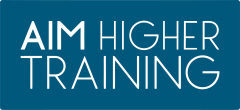Building a Diverse Workforce: Best Practices for Inclusive Hiring
In today’s rapidly changing world, diversity and inclusion have become essential components of a successful and innovative workplace. Companies that embrace diversity in their workforce not only benefit from a wider range of perspectives and talents but also foster a more inclusive and welcoming culture. To achieve this, it’s crucial to implement best practices in inclusive hiring.
In this blog post, we’ll explore the key steps towards building a diverse workforce and provide practical insights for inclusive hiring, focusing on the strategies advocated by Aim Higher Training.
Diverse Talent Sourcing
Firstly, the foundation of a successful and inclusive hiring process is a diverse talent pool. Companies should actively seek out candidates from various backgrounds, experiences, and perspectives.
Collaborate with diverse networks and organisations.
Start by connecting with businesses and organisations, job boards, and events that cater to underrepresented groups in your industry, you can tap into individuals who have the skillset your business needs. As a result this will help your business embrace diversity and gain access a more diverse pool of candidates.
Next leverage technology for bias-free sourcing. By implementing AI-driven tools that can help source candidates without being influenced by bias, ensuring a more diverse talent pool.
Inclusive Job Descriptions
Secondly, create job descriptions that appeal to a broad range of candidates is crucial. By being clear about what duties and responsibilities the role will cover. Finally, list the skills and experience that will help to direct the candidate to a clear understanding of what your business needs.
Avoid gender-specific terms in your job descriptions to ensure that all potential applicants feel welcome. Make it clear that no assumptions will be made about a preferred gender to fulfil the role.
Emphasise qualifications over requirements.
Focus on the essential skills and qualifications needed for the role, rather than a long list of specific requirements, which can discourage diverse candidates. Remember that knowledge and skills can be taught and developed, so concentrate on talent, attitude and potential.
Unbiased Screening and Selection
Thirdly, in order to build an inclusive workforce, it’s essential to eliminate bias from the screening and selection process.
It’s important to standardise interview questions. By developing a set of structured interview questions and weighing these appropriately you can ensure all candidates are evaluated consistently, therefore reducing the impact of bias.
Introduce Blind CV Screening.
As part of the recruitment process remove personally identifiable information from resumes during the initial screening process to focus on skills and qualifications.
Inclusive Interviewing
Inclusive interviews aim to make all candidates feel comfortable and valued. Ensuring there are diverse interview panels that include individuals from different backgrounds and experiences on the interview panel to provide diverse perspectives.
Offer training to interviewers on unconscious bias and inclusive interviewing techniques to ensure a fair and equitable process.
Transparent and Fair Compensation
By ensuring fair compensation is vital to retaining a diverse workforce.
Regularly review compensation to identify and correct any gender or ethnicity-based pay disparities. Review similar businesses in your geographical area and sector to ensure you’re offering attractive salaries and packages, because as a result you’ll be able to attract the best talent.
Communication and Transparency
Ensure you communicate your compensation structure. By being transparent about your compensation structure, you can ensure all employees understanding how pay decisions are made. In fact, by ensuring information is shared with candidates you will generate a transparent and open culture within your business. As a result, employees will feel informed and involved in day to day operations.
Onboarding and Inclusivity
Finally, your onboarding process sets the tone for an inclusive work environment. Ensure you have an inclusive induction and orientation programmes. Through the development of onboarding programmes they emphasise your businesses commitment to diversity and inclusion. Such a programme will help new employees to feel welcome and valued. By introducing new staff to key personnel and supplying them with all the information they will need to support them to succeed in their new roles.
Start to develop mentorship programmes for all new and existing employees. By encouraging mentorship in your organisation you will support diverse employees by establishing a solid support system for new recruits. Always ensure there is a help to support them to navigate the workplace especially during the early weeks of their employment.
In conclusion, building a diverse workforce through inclusive hiring practices is not just a moral imperative but a strategic advantage. A diverse team brings fresh perspectives, fosters creativity, and better reflects the diverse customer base of today’s global market.
At Aim Higher Training we believe in the power of inclusive recruitment and commit to supporting and guiding organisations in this journey. Through the implementation of best practices outlined in this post, you can take significant steps towards creating a more diverse and inclusive workplace, where every employee has the opportunity to thrive and contribute to the company’s success.
Our Commitment
At Aim Higher Training, we remain committed to empowering individuals and organisations to achieve their full potential, and our blog series on workforce development is just one way we aim to inspire positive change in the world of work, education and beyond.
Check out some of our latest blog posts, including:
 Creating an Inclusive Talent Pipeline- Steps to Diversify Recruitment
Creating an Inclusive Talent Pipeline- Steps to Diversify Recruitment
In today’s dynamic and interconnected world, diversity and inclusion have evolved from mere buzzwords to essential elements of a successful and sustainable business.
 Diversity, Equality, and Inclusion: The Future of Recruitment
Diversity, Equality, and Inclusion: The Future of Recruitment
In our diverse world, organisations and businesses are increasingly recognising the importance of building a workforce that reflects the rich tapestry of society.
 Diversity and Inclusion: The Power of an Inclusive Recruitment Strategy
Diversity and Inclusion: The Power of an Inclusive Recruitment Strategy
In today’s rapidly changing and increasingly interconnected world, equality, diversity and inclusion (ED&I) have emerged as not just buzzwords but as critical drivers of success for businesses.
Contact Aim Higher Training to discuss how we can support the development of your workforce plan. We can work with you to recruit and retain the best talent to help your business fly.


One thought on “Building a Diverse Workforce: Best Practices for Inclusive Hiring”